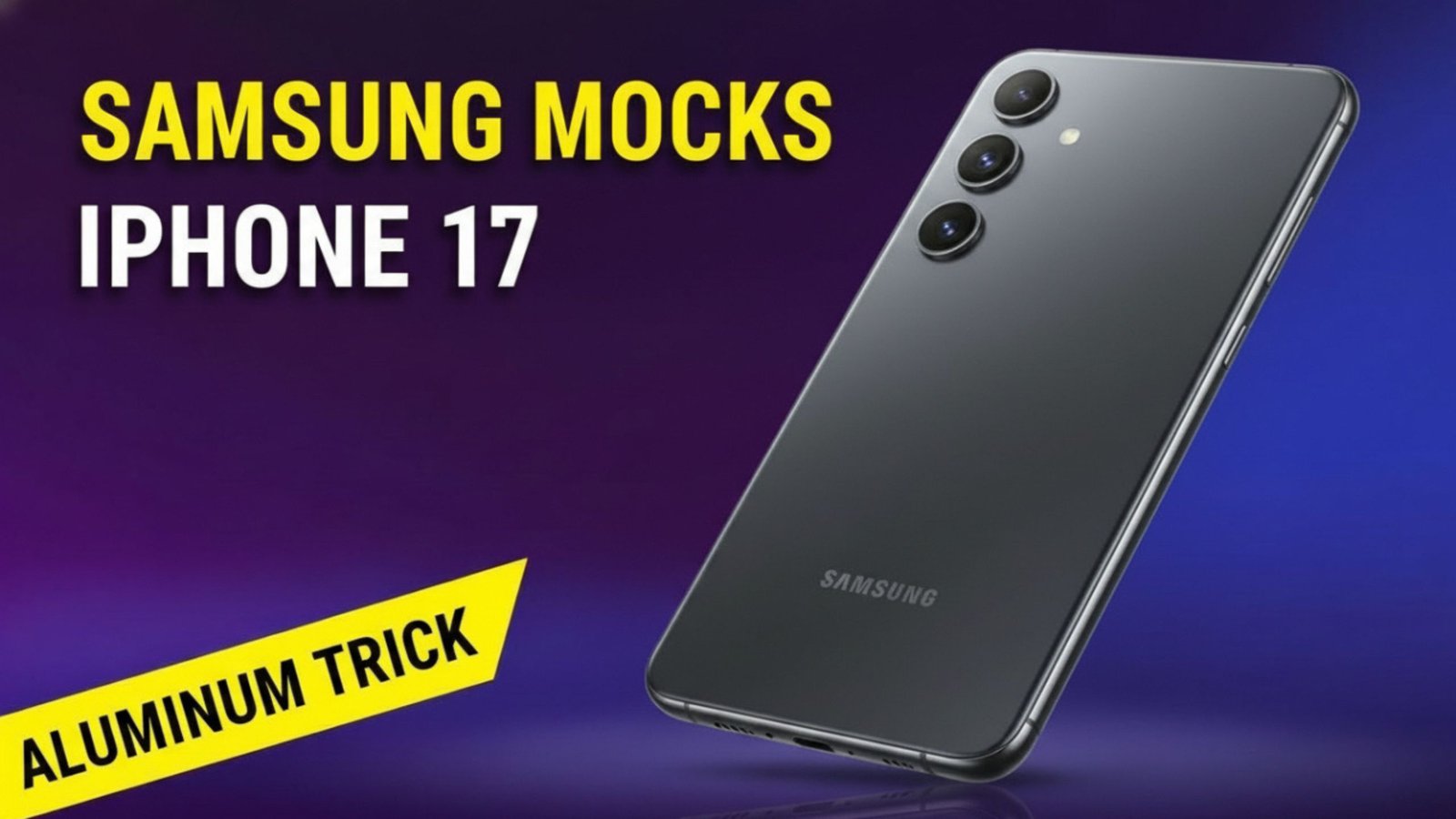Samsung Users Mocking Apple iPhone 17– In a surprising yet amusing twist in the smartphone rivalry, Samsung users have started mocking Apple fans over the recently revealed iPhone 17’s aluminum body, while proudly flaunting their Galaxy S24 Ultra’s titanium design. The playful banter across social media platforms like Instagram and X (formerly Twitter) has reignited the long-standing debate between iPhone and Android users, with Samsung fans using the moment to highlight their brand’s innovation and durability.
Apple’s Aluminum Comeback Faces Titanium Teasing
The iPhone 17 lineup, according to leaks and design previews, will feature an aluminum frame — a material Apple last used extensively before moving to stainless steel and titanium in its premium devices. While the decision was likely made for cost optimization and weight reduction, Samsung enthusiasts didn’t let this slide quietly.
Across the web, memes and short reels have surfaced showing Samsung Galaxy S24 Ultra users flexing their titanium builds, teasing iPhone owners with captions like “Still stuck in 2018 aluminum vibes?” and “Titanium is the new premium, not nostalgia.”
This humorous rivalry reflects how building materials have become a new battleground in smartphone marketing, shaping how users perceive status, durability, and premium feel.
Why Titanium Became the New Gold Standard
Titanium’s introduction in smartphones marks a new era in premium phone design. The Galaxy S24 Ultra, launched earlier in 2024, set a benchmark by adopting a full titanium frame, making it one of the most durable yet lightweight flagship devices on the market.
Key reasons why titanium outshines aluminum:
- Superior Strength-to-Weight Ratio: Titanium offers better resistance against dents and bends compared to aluminum.
- Premium Aesthetic: Its sleek, matte finish provides a luxurious look that stands out.
- Heat Resistance: Titanium dissipates heat more efficiently, ensuring performance stability during extended use.
- Corrosion Resistance: Perfect for longevity and protection from environmental wear.
By contrast, aluminum, though light and affordable, tends to scratch more easily and lacks the “premium hand feel” modern users expect from high-end smartphones.
Samsung Fans Celebrate Their Titanium Edge
As Apple moves back to aluminum frames, Samsung fans have taken the opportunity to remind the tech community that they’re already ahead of the curve.
Many Samsung enthusiasts argue that Apple’s design decisions focus more on marketing narratives than real-world innovation. One viral comment reads:
“Apple is calling aluminum newly refined aerospace-grade material, while Samsung moved to titanium months ago — that’s the difference between following trends and setting them.”
This sentiment resonates strongly within the Android community, where innovation speed and material upgrades are considered essential proof of progress. Samsung’s titanium build has also influenced other manufacturers like Xiaomi and OnePlus, who are now testing titanium variants for upcoming models.
Apple’s Design Philosophy: Elegance Over Evolution?
Despite the mockery, Apple’s decision to switch back to aluminum might not be entirely misguided. According to insider reports, Apple aims to make the iPhone 17 series lighter, especially after criticism of the iPhone 15 Pro Max’s heft.
However, critics argue that Apple’s marketing spin often overshadows the actual material downgrade. Apple’s description of “refined aerospace-grade aluminum” has been widely interpreted as a euphemism for cost-cutting, especially in non-Pro variants.
While Apple continues to excel in software integration, camera optimization, and brand prestige, Samsung’s engineering approach — focusing on building innovation and hardware durability — appears to be winning the hearts of tech enthusiasts.
The Rise of Material Wars in Smartphone Branding
The shift in focus from specs to build materials marks a fascinating evolution in smartphone branding. Consumers now equate titanium, ceramic, and glass composites with luxury and endurance, much like the transition from plastic to metal a decade ago.
Samsung’s titanium strategy not only enhances durability but also strengthens the brand’s premium image. On the other hand, Apple’s design minimalism, though refined, risks being seen as stagnant when compared to the innovation-driven narrative of Android brands.
The mockery trend is a reflection of how consumer identity has intertwined with device material and brand loyalty — a modern cultural phenomenon where tech choices reflect lifestyle statements.
Social Media Reactions: The Meme War Continues
View this post on Instagram
The Instagram reel that sparked the latest wave of trolling (shared here) features a Galaxy S24 user comparing phones, jokingly tapping his titanium body and saying, “Sorry, aluminum’s not invited to the premium club.”
Comments flooded instantly, with both sides taking playful jabs:
- “Samsung users after holding titanium for 3 months think they’re Iron Man.”
- “Apple users still think ecosystem > everything else.”
- “Aluminum belongs in soda cans, not flagship phones.”
This viral moment underscores how social media banter continues to shape brand perception, giving companies free publicity and fueling ongoing Android vs. iPhone debates.
Samsung’s Consistent Lead in Build Innovation
While Apple remains the benchmark for ecosystem cohesion and software optimization, Samsung’s hardware evolution is undeniably faster. The Galaxy S24 Ultra’s titanium frame, coupled with AI-driven photography and adaptive display tech, demonstrates Samsung’s focus on future-ready engineering.
Apple, meanwhile, continues to maintain incremental innovation, prioritizing refined design and brand exclusivity over radical upgrades. But as consumer expectations evolve, especially in durability and performance, Samsung’s leadership in material innovation might become its defining competitive advantage.
Final Thoughts: Titanium Triumphs Over Aluminum
The iPhone 17 aluminum trend has unintentionally reignited the brand rivalry that defines the smartphone industry. While Apple loyalists defend the company’s material choice as strategic and lightweight, Samsung users proudly celebrate their titanium supremacy, emphasizing strength, longevity, and modern luxury.
In the end, this debate is less about metal composition and more about brand philosophy — Apple’s pursuit of elegance versus Samsung’s quest for innovation. However, the public sentiment, fueled by social media trends, currently leans towards titanium as the future of flagship design.
As tech enthusiasts continue to argue online, one thing remains certain: the battle between Apple and Samsung is far from over — and this time, metal matters as much as megapixels.
Ask Follow-up Question from this topic With Google Gemini: Samsung Users Mocking Apple iPhone 17 Aluminium Trend
AITeam is the dedicated editorial team of Android Infotech, consisting of experts and enthusiasts specialized in Android-related topics, including app development, software updates, and the latest tech trends. With a passion for technology and years of experience, our team aims to provide accurate, insightful, and up-to-date information to help developers, tech enthusiasts, and readers stay ahead in the Android ecosystem.
For more about our team, visit our About Us page.




Leave a Reply